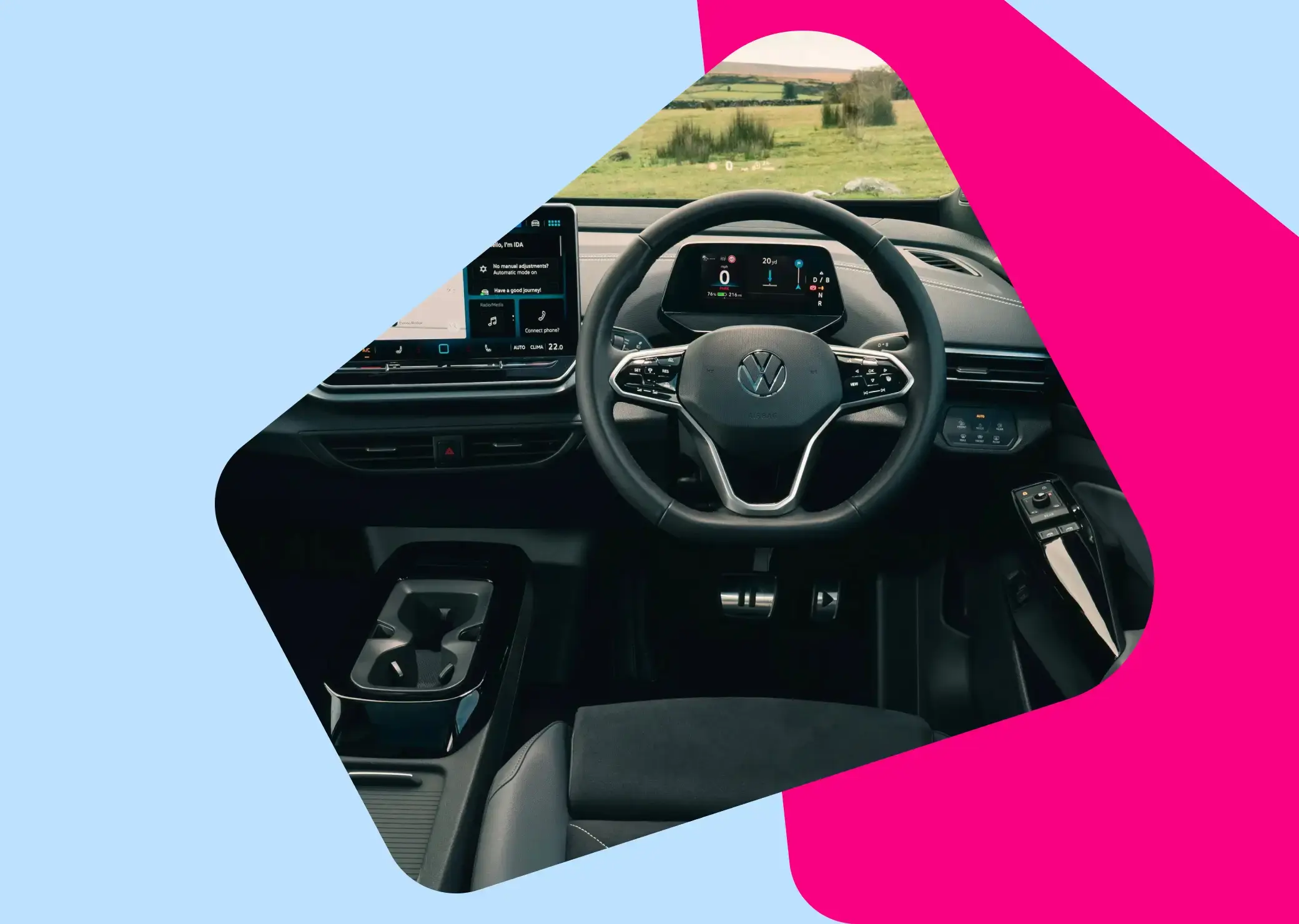- Carmoola
- Blog
- Cars and Gadgets
- What is a car infotainment system?
- 🗞 Cars and Gadgets
- Last updated: Mar 12, 2025
- 11 Min Read
What is a car infotainment system?
Written by

Verified by


See how much you can borrow in 60 seconds
| Representative Example | |
|---|---|
| Loan amount | £10,000 |
| Interest rate | 13.9% APR |
| 54 payments of | £246 |
| Total cost of credit | £3,284 |
| Option to purchase fee | £1 |
| Total payable | £13,285 |
Rewind the clock to the 1980s and you were considered lucky if the infotainment offering in your vehicle consisted of an FM radio and a dog-eared copy of an AA Road Atlas strewn upon the parcel shelf.
Crystal-clear touchscreens with constantly-connected digital navigation and a plethora of interactive applications wouldn’t arrive until the 2010s, with Tesla arguably reinventing what it meant to introduce smartphone and tablet-like technology into a car.
A neat portmanteau of information and entertainment, the humble infotainment system is designed to do just that: offer important vehicle information, alongside things like radio and other audio services.
Most vehicles sported whatever audio technology was big at the time, be it an AM/FM radio tuner, a cassette tape deck or a CD player, with most European manufacturers opting to introduce the Deutsches Institut für Normung (or DIN) standard for most vehicle head units. Put simply, it’s a fancy name given for the slot where a head unit sits in the dash - made to a universal measurement so it can easily be removed, replaced or updated.
Throughout the 1980s, 1990s and even early 2000s, these classic DIN radios will have typically accepted a CD (perhaps multiple if you had a multi-disc changer in the boot), with a fairly basic LCD screen offering volume and track information.
BMW was among the first manufacturers to move away from the removable DIN head unit system and embed a screen into the dashboard when it introduced its iDrive system on the 2002 7 Series. This 8.8-inch screen was controlled by a rotary dial and was one of the first to offer satellite navigation, without the need for a separate unit suckered to the windscreen from the likes of TomTom or Garmin.

What are the key features of an infotainment system?
Fast-forward to today, and the technology in modern cars goes well beyond offering a way to play cassette tapes or CDs, as most now feature built-in navigation, the ability to tether a smartphone to make hands-free calls, as well as access favoured audio streaming services thanks to the implementation of a built-in 4G or 5G-ready SIM card.
Although this sort of thing used to be the reserve of more expensive premium vehicles, some of the best infotainment systems can now be found on more affordable models, including small family cars and even compact city cars.
Interaction is now most often through a high-resolution touchscreen display, although some manufacturers still offer physical hard keys, dials and other ways to navigate menus.
There has been some consumer backlash in recent years due to the fact that too much key vehicle functionality is being committed to touchscreen displays, often proving distracting for drivers, as they have to wade through complicated menus to turn on or disable simple vehicle systems… but more on that later.
One of the biggest changes in recent years has been the introduction of Apple CarPlay and Android Auto, which allow drivers to plug in their preferred smartphone and mirror a selection of authorised apps on the vehicle’s larger infotainment display.
Both Apple and Android (itself powered by Google) carefully monitor the sort of applications that function on their respective screen mirroring services, only allowing those that have been specially developed to reduce driver distraction.
What are the different types of infotainment systems?
It is still possible to find new vehicles with very basic infotainment systems, but even those tend to offer a touchscreen display and a way to at least mirror the content on your smartphone.
Because of this, some manufacturers will offer entry-level models that don’t feature built-in navigation, instead pushing drivers to use Google or Apple Maps, which in turn use data from a smartphone provider, with FM and DAB radio providing the audio entertainment.
Buyers of older second-hand vehicles will still come across those fitted with a basic CD player or FM radio, but thanks to the DIN system, these can easily be upgraded to something more modern - often requiring very little effort when it comes to fitting out.
Aftermarket head units from the likes of Pioneer, Alpine and Sony can offer a very similar touchscreen experience to those systems offered as standard on new cars, opening up the opportunity for Apple CarPlay and Android Automotive to be introduced to even some of the oldest cars on the road.
However, due to the nature of an aftermarket head unit, it won’t be styled to look like the rest of the vehicle’s interior and the larger, flashier displays can look a little out of place on those older cars that were simply not designed to have one.
If you’re thinking about bringing an older vehicle up to speed with a new aftermarket head unit, check the DIN type first. Some cars use a Double-DIN system, which is large enough to house monster touchscreens.
Single-DIN units, which often housed a basic FM radio or cassette tape player, won’t be large enough to have a large modern touchscreen sit flush in the dashboard. However, there are a number of aftermarket head units that offer generous screen real estate, but are designed to fit in a single DIN slot. However, the screen will jut out from the dash and can look a little awkward.
Are infotainment systems safe to use?
Most modern infotainment systems are designed by UX (user experience) specialists and software engineers to distract drivers as little as possible, but as manufacturers look to cram an ever-increasing number of digital features onboard, driver distraction is inescapable.
For example, when Volkswagen first unveiled its ID range of electric vehicles, a number of journalists and customers bemoaned the brand for producing an infotainment system that was distracting and difficult to use. Too much was committed to touchscreen and haptic feedback buttons, which lay flat on a dashboard surface and can be difficult to locate, to control important vehicle functions.
The German marque has since updated its offering, but there are still manufacturers out there that have created tricky-to-navigate digital experiences that can force drivers to take eyes off the road when attempting to adjust some simple parameters.
To combat this, a number of automakers have started introducing AI-powered voice assistants, similar to those found on today’s smartphones. This allows drivers to adjust vehicle settings, heat up or cool a cabin, route to a destination or even enquire about the weather using simple voice commands and natural speech.
Again, there is a discrepancy between those voice assistants that work well and those that are clunky to use or easily confused. Tethering an Android or Apple smartphone usually means owners can make the most of the built-in voice assistants, such as Apple’s Siri and Google’s Alexa, to control much of the phone’s functionality.
Above all else, it all comes down to responsible use of an infotainment system and anything that requires too much focus, such as manually inputting complicated addresses into the sat nav or hunting for an obscure podcast, is best left to when the vehicle is parked.

What does the future of in-vehicle infotainment look like?
As technology moves on at a lightning pace, the digital offering inside of vehicles is only going to become more elaborate. Screens and displays are playing the starring role in the next generation dashboards, voice assistants are becoming smarter and integration with owners’ digital lives will only deepen.
Even today, drivers can control smart devices in the home as they return from work, check important diary entries on the way to meetings and even join Zoom calls when parked up.
As previously mentioned, Tesla arguably set the precedent in 2012 with the enormous 17-inch portrait display found in the original Model S. More of a ‘computer-on-wheels’ than a vehicle, this system can be constantly updated via over-the-air (OTA) updates.
Tesla argues that its vehicles only improve over time, rather than gradually degrading and hurtling towards obsoletion, like many older internal combustion engine cars.
Plenty of manufacturers have followed suit and by embedding a SIM card into the vehicle to provide data and a stable internet connection, today’s infotainment systems can update as frequently as an Apple or Android smartphone does.
This means access to the latest apps, improvements in navigation and routing, fresh graphics and layouts, as well as the ability to unlock entirely new vehicle features, such as improved performance and range where electric vehicles are concerned.
Often referred to as the Software Defined Vehicle (or SDV for short), this next generation of car will become increasingly reliant on and governed by its infotainment system. It is highly likely that future buyers will even base their purchasing decision on the quality of the digital offering, rather than a vehicle’s exterior styling or performance.

How to choose the right infotainment system for your car
Many modern motorists are perfectly happy with an infotainment system so long as they can tether a smartphone and make use of their favoured apps. In this case, looking for a vehicle that offers Apple CarPlay and Android Auto compatibility is key - depending on the phone you own.
This may still require plugging said device into a USB or USB-C input, but wireless CarPlay and Android Auto is becoming increasingly commonplace, with wireless charging trays ensuring phone batteries remain topped up.
If you prefer to use a mobile phone purely for calls and texts, it helps to have an infotainment system with built-in satellite navigation, which makes routing to a destination simpler and less stressful.
Similarly, systems with hands-free calling features ensure it is safe and legal to take phone calls while driving, although even basic infotainment offerings with Bluetooth capabilities and a microphone can accommodate this.
The sheer weight of infotainment features on a modern car can make the buying decision feel a little daunting, but really, the amount you actually need will come down to personal preference.
Conversely, with the proliferation of excellent aftermarket head units, even the oldest cars can be brought bang up to date with a simple infotainment refresh.
FAQs about car infotainment systems
What is Apple CarPlay and Android Auto?
What is Apple CarPlay and Android Auto?
The systems allow drivers to mirror a select number of applications from their Apple or Android phones on a vehicle’s infotainment display. The feature is sometimes offered as standard in new cars and is accessed by plugging a device into a USB or USB-C input, or wirelessly if the vehicle has that capability.
Can I install an infotainment system in my old car?
Can I install an infotainment system in my old car?
Yes, as many electronics manufacturers specialise in head units that fit into the space where an old radio or CD player once resided. These units can even come preinstalled with satellite navigation, or offer Apple CarPlay and Android Auto functionality.
Are car infotainment systems safe to use while driving?
Are car infotainment systems safe to use while driving?
If used responsibly, car infotainment systems are safe to use while driving. Most applications are deliberately designed to reduce the risk of distraction by limiting search functionality to voice commands or disabling the ability to respond to messages with a keyboard, for example.
How much does it cost to upgrade an infotainment system?
How much does it cost to upgrade an infotainment system?
The most basic car stereo and head unit receivers can cost as little as £50, but these will typically only offer radio and Bluetooth connectivity to stream audio from a device. Those with touchscreen displays and Apple CarPlay or Android Auto functionality start at around £150, but can easily top £1,000 for the more technically accomplished models.
Do all infotainment systems support Bluetooth?
Do all infotainment systems support Bluetooth?
It is very rare to find a modern infotainment system that doesn’t support Bluetooth, as this forms the connection between a smartphone or other personal device to allow things like audio streaming and hands-free phone calls.
Some basic head units in older cars might not support Bluetooth, in which case it might be worth considering upgrading to a modern system that will fit into the single or double DIN opening in the vehicle’s dashboard.
See how much you can borrow in 60 seconds
| Representative Example | |
|---|---|
| Loan amount | £10,000 |
| Interest rate | 13.9% APR |
| 54 payments of | £246 |
| Total cost of credit | £3,284 |
| Option to purchase fee | £1 |
| Total payable | £13,285 |
Related articles
What are the best family cars?
Choosing the perfect car for you and your family can make life easier for everyone. Whether it’s the school run, a day out with...
What are the best 7-seater cars?
The best seven-seater cars can be game-changers – giving you enough space – and seats – to transport family or friends without...
Driving With Kids - Fines and Driving Laws You Need To Know!
When it comes to driving with children in the car, most drivers are extra cautious and keep an eye out for any potential dangers...

.webp?width=832&height=592&name=customer-support%20(1).webp)










.webp?width=400&height=285&name=online-shoppers-with-dog%20(1).webp)


.jpg?width=500&height=356&name=Vintage%20car%20going%20to%20an%20old%20town-1%20(1).jpg)





